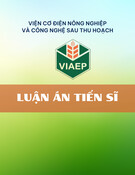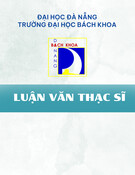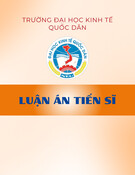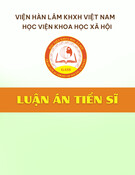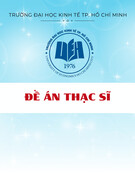MINISTRY OF EDUCATION AND TRAINING CAN THO UNIVERSITY
SUMMARY OF DOCTORAL DISSERTATION Specialization: Soil and Water Environment Code: 62 44 03 03
RESEARCH ON RICE STRAW TREATMENT SOLUTIONS
FOR IMPROVING THE ENVIRONMENT OF
PADDY SOIL IN THE MEKONG DELTA
Can Tho, 2016
The dissertation was completed at: College of the Environment and Natural Resources Can Tho University
Scientific Supervisor: Ass.Prof.Dr Truong Thi Nga
The dissertation will be defended before the council of the university level
At ... .. ... .. hour ... day ... .. month .. Year ... ..
Meeting at:
Opponent 1: Opponent 2: Opponent 3:
Further information of the dissertation could be found at: Learning Resuorse Center, Cantho Unniversity.
National Library of Vietnam
CHAPTER 1: INTRODUCTION
1.1 The necessity Nowadays, the food needs have been increasing in Vietnam and particular in the Mekong Delta. The Mekong Delta with about 4.24 million ha has contributed to ensuring strategic domestic food security and export. However, rice yield tends to decrease in the intensification rice area in recent years. It is caused by improper soil use leading to degraded soils. In the case, triple rice cropping has reduced the decomposition of organic matter and the activity of beneficial organisms in the soil so reducing ability to provide nutrients in soil for rice. Besides, on-field rice straw burning did frequently after each harvest contracts affecting the source of organic matter and nutrients. In addition, the straw burning has also affected to the environment and human health. Straw burning after harvest is one of the causes of environmental pollution, greenhouse gas emissions such as CO2, CO, NOx, CH4. The recent studies have showed that organic fertilizer from straw of rice might be increase soil fertility, contributing to stabilizing sustainable the intensification soil and rice yield. Cuu Long Delta Rice Research Institute reports showed effectiveness of organic by-products from agricultural waste products on reducing fertilizer and increasing income for farmers (Tran Thi Ngoc Son et al, 2009; Luu Hong Man, 2010). Currently in the Mekong Delta, rice harvest by combine harvester, straw was scattered on the ground for biodegradable or was burnt or was incorporated into the soil after harvest. So implement technical solutions to treatment of straw in the field is necessary that reducing rice straw burning contract to environmental protection, improved soil properties. 1.2 Research objectives
* Overall objectives: Research and propose the solutions to treat straw in the field so that reducing on-field rice straw burning and improving the soil properties in intensive rice soil. * Specific target: - Evaluating the current situation of straw treatment in intensive rice soil at Tien
Giang Provine.
- Assessing the effect of rice straw burning on the physical and chemical properties of intensive rice soil. - Testing the possibility of and rice straw decomposition process in the field
with the addition of bio-product.
- Evaluating the effectiveness of incorporated rcie straw in the field on soil physical and chemical properties. - Suggestion of rice straw treatment processes in the field.
1.3 Research content
- Surveying the current usage and treatment of rice straw after harvest in Tien
Giang province.
- Assessing soil physical and chemical properties with continuously burning
rice straw in Cai Be district, Tien Giang province.
- Research compost from rice straw and treatment rice straw with bio- products
in the field.
1
- Evaluation soil physical and chemical properties (from Winter-Spring 2013
to Spring-Summer 2015).
- Applycation the rice straw treatment process in the field.
1.4 The new contributions
- Assessing the current usage of rie straw treatment and soil properties with continuously burning rice straw in Cai Be district, Tien Giang Province (2013 - 2015). - Selection of probiotics which effectivelly for compost from rice straw
treatment and rice straw incorporated in the field.
- Assessing decomposition rate of incorporated rice straw with added bio-
- Assessing the effect of incorporated straw on soil physical and chemical products. properties and rice yield in Cai Be district, Tien Giang Province. - Recommended rice straw treatment process instead of burning rice straw on
- The results support the scientific data on soil properties in case of burning or
- The research provide the basic scientific data for teaching and researching in
- The results can be used as reference citation for the rice straw treatment on the
- The process of rice straw treatment can be applied in similar condition
the field in Cai Be district, Tien Giang Province. 1.5 Scientific and practical significances * Scientific non-burning rice straw. similar topics in rice straw treatment. field by probiotics. . * Practical - The thesis provides scientific information on soil properties in case of burning or non-burning rice straw to the managers, policy makers on planning strategies of rural development and moderm rural area. The results of the thesis could use to recommend farmers on rice cultivation with non-burning rice straw which are toward to sustainable rice cultivation.
2
CHAPTER 2: LITERATURE REVIEW
2.1 Rice production and environmental problems in rice production 2.1.1 Rice production in the Mekong Delta and regional research Viet Nam with a population of over 90 million people, the majority of people live in rural areas and agricultural activities. Rice is the staple crop of the Mekong Delta (MD), occupying leading positions in agricultural crops. Tien Giang is one of the major rice producing provinces in the Mekong Delta. Most of the districts are producing three crops of rice, Cai Be district is particularly rice production three crops consecutive and has the largest rice production. Rice production 2013 and 2014 in Cai Be district of approximately 320,000 - 330,000 tonnes/year which means about 330,000 tons/year of straw. Due to continuous rice cultivation and to prepare a new service contract to burn farmers to utilize the time and cost for new services. Burning Council will lose large amounts of organic waste, gases and environmental pollution (Gadde et al., 2009; Tran Ba Linh et al., 2010; Vo Thi Guong et al., 2010 , Nguyen Mau Dung, 2012 ; Truong Thi Nga et al., 2013) . 2.2 The study on straw treatment
Recently treatment straw by Trichoderma and composting showed good results in environmental protection , against harmful fungi in the soil , reducing the amount of fertilizers and reduce production costs rice (Tran Thi Ngoc Son et al., 2010).
According to Nguyen Thanh Hoi (2008) study "Effect of the incorporation of raw rice straw stubbes in submerged soil on the growth of rice (Oryza sativa L.) in the Mekong Delta" showed that 37% of the dry weight of straw deposited in the soil after buried in flooded rice paddies 90 days. Drain water at the beginning of the arable land at the time of 15 or 30 days after sowing continuously for at least 5 days (ground-level water level 10-15 cm) on flooded rice soil with fresh straw was buried improve the growth and increase the yield of 22% (experiment in pots) and 15 % (field experiments) compared to continuous flooding. According to Nguyen Kim Chung (2008) study "Intensification of rice and effective use of bio- organic fertilizer high-yield rice in the Mekong Delta" showed, straw manure decomposition by fungi Trichoderma for rice from 2-4 tons of straw/hectare will increase the nutrients in the soil, limited use of chemical fertilizers, do rice development in conditions of balance less disease, gradually increase rice yield in the following season and effectively increase profits about 2-3 million/ hectare According to Ha Thi Thanh Binh (2008) study, "Use of phosphate fertilizers in order to expedite the resolution of straw as fertilizer in the spring" has conducted experiments to evaluating the effectiveness of phosphate fertilizers used to promote the underwear straw decomposition. Plough to buring straw as fertilizer in the spring season when the highest effective manuring mixture of 25% nitrogen, 50% associated with 50% superphosphate and calciphosphate 10 days before sowing, top dressing 2 times: 10 days after sowing and 24 days after sowed. According to Luu Hong Man (2010 ) study "Application of bio-products for the production of organic fertilizer in place of straw to improve soil fertility cultivation" Straw after treatment with Trichoderma sp probiotics to create sources of organic fertilizer -intensive model of rice dropped from 20-60 % of chemical fertilizer without reducing yield. According to Tran Thi Anh Thu (2010) with the theme "Impact of straw
3
treatment with Trichoderma sp. to soil fertility at the 2010 summer-autumn in An Giang Province" showed when fertilizing straw treated with Trichoderma combination preparations with 70% under the NPK fertilizer used by farmers to increase organic carbon, N, phosphorus and potassium fertilizer exchange than under the agricultural practices (burning and fertilizer combined 100 %). Tran Thi Ngoc Son et al., (2011) with the theme "Studying the effect of straw treatment with Trichoderma bio-product to yield and economic efficiency in the rice- growing in the Mekong Delta" results showed that effective preparations Trichoderma quick straw treatment in the field, suitable for cultivation in the Mekong Delta conditions, reduces C/N ratio of 20.4 to 21.4 straw and increased levels of NPK. Straw treatment with preparations helped reduce around 30% of NPK fertilizer and increase rice productivity as well as increase economic efficiency and improve paddy soil properties. Tran Thi Mil et al., (2012) studied the effect of the inclusion of straw into the soil with the fungus Trichoderma, the compost from sewage sludge catfish ponds and straw burning (rice sowing buried 3 weeks). The results showed that straw buring Trichoderma help increase the organic matter content, biodegradable organic N and N useful in the soil. Tran Ngoc Huu et al., (2014) with the theme "Components of NPK mineral nutrient from rice straw compost and its efficiency for growth improvement and rice yield" the results showed straw compost with nitrogen-fixing bacteria Azospirillum lipoferum increases protein content in manure. Rice yields reached 0.51 kg/m2 when incubated with straw fertilizing fungus Trichoderma combination with nitrogen-fixing bacteria and phosphate dissolving bacteria higher than 0.41 kg/m2 of distributed straw brewed only with Trichoderma.
Nguyen Quoc Khuong et al., (2014) with the topic "Effects of the rice straw compost incorporation on methane and nitrous oxide emissions and rice yield in the greenhouse condition", it was found in experiment conditions, straw compost fertilizer with Trichoderma 6 tonnes/ha has increased the number of panicle/m2, number of grains/panicle, percentage of grains and thus increase yield.
4
CHAPTER 3: CONTENTS AND METHODOLOGIES
The research with 5 main contents were displayed in the detail and specific
Objective: Assessing the current usage rice straw and rice straw treatment
Location of collected sample: Samples were collected in Hau My Bac A
+, P available, K exchange.
-, NH4
The evaluated criteria: pH, soil density, soil texture, organic matter, total
The research aimed to compare the solutions compost from rice straw and
3.1 Contents and methodologies methods below: 3.1.1 Contents 1. Surveying the current rice straw usage and treatment after harvest in intensive rice cultivation area in Tien Giang Province after harvest. Form and scale surveying: Survey 100 rice cultivation households each district, households are local people with an area of rice cultivation more than 0.5 hectares with their long experience in rice cultivation. Interview content consist of rice cultivation history, the history of burning rice straw, rice varieties, fertilizer method, harvesting methods, rice straw management, period uncultivated between two rice crops, rice straw burning methods, knowledge of rice straw treatment and using probiotics in the treatment of agricultural waste. 3.2.2 Contents 2. Surveying, evaluate soil physical and chemical properties with continuously rice straw burning in Cai Be district, Tien Giang province. Objective: Evalue chemical and physical properties of rice cultivation soil with continuously rice straw burning so that assessment the effects of rice straw treatment in the field on the soil properties. Commune and Hau My Bac B Commune, Cai Be district, Tien Giang province. Time of sample: Collect and analysis of soil samples in March 2015. Soil samples were collected in the area of rice cultivation with continuously rice straw burning (over 35 years) and with rice straw non-burning. nitrogen, total phosphorus, C/N ratio, NO3 3.2.3 Contents 3: Research compost from rice straw and treatment rice straw with bio-products in the field. choosing available bio-product treatments in the field. + Content 3.1: Research compost from rice straw with bio-products. - Objective: Choosing available bio-products for making compost from rice straw to rice straw burying in the field. - Scale of experiment: The experimental design was a randomized complete block design with 3 replications of 5 treatments. Rice straw was treated with bio-products to the following treatments: Table 3.1: Treatment composting experiments from straw
Treatment treatment 1: treatment 2: treatment 3: treatment 4: treatment 5: Symbol DC B T E NT Formula Rice straw Rice straw + Biomix bio product Rice straw + Tricho-Compost bio product Rice straw + Emic bio product Rice straw + Biogas waste water
5
+ Content 3.2 : Rice straw was treated with bio-products in situ. Objective: Researching into rice straw was treated with bio-products in situ. Assessing effects of treated rice straw with bio-products on soil physical and chemical properties and rice yield. This result suggest treated rice straw with bio-products on the field for famers.
Study site and time: The experiment was conducted in the Hau My Bac B commune, Cai Be district, Tien Giang province in the Spring Summer 2013, Spring- Summer 2013 and Spring-Summer 2014.
Implementation method: Researching with 3 experiments is presented below: Experiment 1: Evaluation of the straw treatment with Trichoderma - DT bio- product, Biomix bio-product and AT bio-decomposer to soil physical and chemical properties.
The experiment to evaluate the rice straw treatment affects physical and chemical
properties of soil and yield. Tracking indicators: Collected soil samples for analysis of indicators: pH, EC, organic matter, total nitrogen, N available, total phosphorus, P available, C/N ratio and soil density. + Testing rice straw in trellised was incorporated in the soil
The aimed: Assessing the rice straw decomposing over time. Measuring pH, EC, Eh of rice straw in trellised bag in field conditions. Rice straw were analysed in the laboratory of %C, total N, C/N ratio and weigh dried (drying 105oC).
Table 3.2: Rice straw treatment with bio-products in situ.
Formula
Treatment treatment 1: treatment 2: treatment 3: treatment 4: treatment 5: Symbol NT1 NT2 NT3 NT4 NT5 Rice straw burning. Rice straw without bio-product. Rice straw + Trichomix-DT bio-product Rice straw + Biomix bio-product Rice straw + AT bio-decomposer bio-product
Experiment 2: Evaluation of effectiveness of rice straw treated with Trichoderma - DT, Biomix bio product in the next year (Spring Summer 2014) Objective: Choosing bio-products treatments which had effectively decayd rice
Subscribe to experiment and evaluate the results: rice yield.
straw. 3.2.4 Contents 4. Evaluation soil chemical and physical properties through incorporated rice straw treatment with bio-products
Objective: Evaluation of soil physical and chemical properties when
incorporated rice straw treated with bio-products in the field. 3.2.5 Contents 5. Implement processes practical application straw treatment
6
solutions in the field
Objective: Application and verify the test results in practice, evaluating the
Data collected is processed and calculated by Microsoft Excel 2013 and
effectiveness straw treatment to soil properties in the field. 3.3 Data analysis methodologys statistical analysis by SPSS version 16.0
7
CHAPTER 4: RESULTS AND DISCUSSION
4.1 Evaluation of straw treatment methods after harvest 4.1.1 Straw treatment methods Surveys was conducted at 100 households in every district of rice-cultivated area in Tien Giang: Cai Be, Cai Lay, Cho Gao, and Go Cong Tay. The result indicate that after rice harvest, the farmers apply simple methods to handle the remaining straw: burning, selling, raising straw mushroom or water melon, using it as animal feed, and leaving it on the paddies. To assess the management of straw on a crop basis, the straw-burning issue in the three winter-spring, spring-summer, and summer-autumn crops was brought to concern. In the winter-spring crop, most of the farmers who conducted the survey burn their paddies after harvest. In Cai Be and Cai Lay districts, there were more than 92% of the farmers stating that they burned their paddies after harvest, whereas a small friction of them for water melon raising. However, in Cho Gao District, 95% of the farmers answered that they would utilize the straw for animal feed, water melon and straw mushroom raising, those who do not breed would sell the straw as cow feed, while the remaining 5% assumed that in rural area, where transportation faced in difficulty, people would burn the straw. The survey indicate that there was a diversity in straw treatment method after harvest, and burning was the most common method within the studied area. In Cai Be and Cai Lay districts, after the summer-autumn crop, the paddies were full of water, so there was an alternative method besides burning, which was leaving the straw to be decomposed in the flood season. Regarding to the decomposition of straw, a quarter of farmers in Cai Be District leave the straw for natural decomposition on the paddies at the end of the summer- autumn crop, and 54% of the farmers in Cai Lay District used the similar method. This method is sorely available in the flood season. Mekong Delta has 3 months of flood, which provide enough time for the straw to be decomposed and the process would provide the soil with nutrition. Therefore, natural decomposition is an option for straw treatment in the flood season for the farmers. The study also showed that the farmers merely have any straw treatment method that is suitable to the local cultivation methods, hence, a study in a suitable treatment has the support of the public opinion. 4.1.2 Methods of harvest
People used to harvest manually, and the procedure hardly prevented the low useful percentage, which lowered the productivity. Recently, the advancement of technology, which resulted in the service of the combine harvester, eased the burden of harvest procedure by saving time and man-power. However, there is a small portion of paddies that cannot apply this harvest method as the combine harvester can only work on 97.7% of the households. 4.1.3 Use of fertilizer In the winter-spring and summer-autumn crops, the use of fertilizer mostly reached 430kg/ha (including urea, DAP, K, NPK (20-20-0; 20-20-15; 16-16-8)). As the three crop model washed away the nutrients from the soil, more fertilizer was applied in the winter-spring and spring-summer crops (there is an increase of 25% in every kind of fertilizer in the next crop; and the urea usage is 30kg/ha for the sewing) The average fertilizer consumption: (150 Urea + 200 DAP + 80 Kali)/ha/crop,
8
equivalent to (105 kg N + 92 kg P + 48 kg K)/ha/crop (with Urea: 46% N, DAP:18 N:46 P, Kali: 60% K).Regarding to the local urea usage, the usage of 60-80/kgN/ha/crop covered 38%, whereas the usage of 80-100 kgN/ha/crop covered 46.7%. According to Ngo Ngoc Hung et al. (2004), the suitable nitrogen contain for rice in average and low alkaline soil is 80-100 kgN/ha/crop. 4.1.4 Advantages and disadvantages of the farmers’ straw treatment methods Every treatment offers advantages and benefits, as well as many disadvantages. If the burning were well-controlled as in several advanced country, the pollution issue would be solved. Table 4.1: Advantages and disadvantages of straw treatment methods
Treatment
Advantages
Disadvantages
Paddies burning
Polute the environment Decrease organic matter supply for the soil.
Decomposition
Exterminate pathogens, pests Rapid and clean treatment of waste straw Provide organic matter to the soil
for
time
certain
Animal feed
Straw mushroom cultivation Watermelon cultivation Compost fertilizer
Need decomposing process Decrease organic matter supply for the soil Decrease organic matter supply for the soil Use limited amount Hard to apply
Take advantage of waste straw Limit paddies burning (minority) Offer economic benefits Enrich the soil environment. Practice crop rotation for better soil quality Limit paddies burning Provide organic matter to the soil
Conclusion: The study results showed that the use of straw mainly were: animal feed, selling for animal feed, mushroom and watermelon raising, filed burning, and natural decomposition (leaving straw on the paddies or mix it with soil in the paddies in flood season). After the winter-spring crop, 92-97% of the responses in the study area burned their paddies after harvest, except Cho Gao District, where about 95% of the households made good use of straw. The process of agricultural mechanization changed the harvesting method, which forced all the farmers burned their paddies by spreading the straw. In the study area, the high fertilizers application of the farmers led to high production costs and ended up with lower profits. People preferred to burn the straw and lacked of proper treatment, therefore, further research on producing compost from straw is a solution to handle large straw supply at the end of every rice crop and contribute to environment protection. Besides, the supply of compost is a method of producing microorganisms, which would enrich the soil in return. Hence, straw treatment on the paddies is a suitable solution for the intensive rice cultivation in the region. To evaluate some physical and chemical properties of rice intensification soil which applied permanent burning method, surveys, sampling, analysis and evaluation of soil physical and chemical properties were conducted. 4.2 Analysis and evaluation of soil properties in permanent burned and unburned paddies
9
Pdt (mg/kg)
CHC (%)
Nt (% N)
pH
The research on soil properties in permanent burned and unburned paddies in Cai Be District was carried out in March, 2015. Prior to this research, a research in permanent burned and unburned rice paddy was conducted in Cai Be District and Tan Phuoc District in March, 2013. Based on these results, farmers in Cai Be District applied intensive rice cultivation with permanent burning method. In contract, farmers in My Thuan hamlet and My Trung hamlet of Hau My Bac B commune and Hau Phu hamlet of Hau My Bac A commune combined rice cultivation with using straw for vegetables. Based on field studies and information provided by local agricultural officers, the location of sample collection was decided. Analysis results showed that in My Thuan hamlet and My Trung hamlet of Hau My Bac B commune, soil physical and chemical properties have tended to increase in nitrogen and phosphorus in paddies with no burning process applied. The results are projected in Table 4.7. Table 4.2: Comparison of burned and unburned soil properties. Soil physical and chemical properties Pt Method (%P2O5)
+ NH4 (mg/kg) 16,02±9,95
+ NO3 (mg/kg) 3,67±3,67 57,93±21,46
Ktd (meq/100g) 0,35±0,08
Burned
4,88±0,28 0,334±0,04 0,12±0,02 6,43±0,89
Unburned P
4,85±0,21 0,333±0,04 0,20±0,08 10,34±1,35 21,57±19,59 0,809
0,986
0,46
0,02
0
3,14±4,45 103,52±66,47 0,70±0,45 0,787
0,068
0,035
The soil properties would be analyzed in the following sections.
4.2.1 Density of rice cultivation soil The study results showed that soil of paddies applying intensive farming with burned straw has a statistically significant difference in density of 0.99 g / cm3 - 1,02g / cm3 compared to soil in unburned paddies. Straw buried in the soil would return part of the organic matter to the soil (Brady (1996), Tran Ba Linh et al. (2008)). Soil in unburned paddies had low density due to the supplemented organic material from straw, waste from plant was retained in the soil. In addition, crop rotation practices contributed to the improvements of soil properties as this is a source of organic matter for the soil. (Tran Ba Linh et al., 2008; Vo Thi Guong et al., 2010). 4.2.2 pH value of rice cultivated soil Soil pH in areas of burned paddies in Cai Be District varied from 4.61-5.08 and had no differences in the two straw treatment methods. The pH value would affect the mineralization of nitrogen, maximize the effectiveness of nutrients, and affect the decomposition of unfavorable organic matter for mineralization in the soil (Staley et al. (1990); Nguyen My Hoa (2012)). The study results fitted with a research by Tran Ba Linh et al. (2010) indicated that soil pH in intensive farming paddies is average acidic according to the USDA scale (1983), and showed that the pH value of soil matched the soil of Mekong Delta (Ngo Ngoc Hung, 2009; Tran Ba Linh et al., 2010). pH value of cultivated soil tended to be acidic because of the root activity and occurring chemical and biological reaction in the soil. The study results stipulated that the pH value of burned and unburned paddies had no statistically significant difference at the 5% significance level. 4.2.3 Organic matter content The study results showed that soil in unburned paddies had a higher organic matter content with a statistically significant difference compared to that of soil in
10
+-N content
+-
In wetlands, the main form of nitrogen that provides nutrients for plants is NH4
Experimental results indicated that NH4
- content
+, which contributed to increasing the amount of NO3
The study results showed that the NO3
burned paddies, with the organic matter content ranged from 10.08% to 10.49%. The study results matched with studies of Tran Ba Linh et al., 2008; Vo Thi Guong et al., 2010, and Tran Thi Ngoc Son et al., 2010, which indicated that farming practices such as cultivation with organic fertilizers, unburned straw treatment or crop rotation increased the organic matter in the soil. Field surveys showed that straw was spread out and burned. This farming practice was declining organic matters content in the soil. 4.2.4 Total nitrogen content The study results showed that the total nitrogen content of soil in burned paddies was 0.334% ± 0.04, whereas that in unburned paddies was 0.334% ± 0.04 with (P: 0.986), which had no statistically significant difference in both straw treatment methods. However, the results indicated that the land in the surveyed area was rich in total nitrogen content according to Kyuma scale, (1976). The unburned straw treatment method might offer an environment with higher organic matter content which supported the activity of microbiological life, and in turn, these microorganisms used up certain amount of nitrogen for their own development, declining the total nitrogen content in the soil. Although a large amount of nitrogen fertilizer had been consume, the absorption of the crop was limited. The nitrogen content of the soil in unburned paddies was consistent with the results of research on organic matter content in the soil due to the total nitrogen content close related to the organic matter content of the soil. Land with high organic matter content, total nitrogen content is usually high (Vo Thi Guong et al., 2010). 4.2.5 NH4 N format (Shouichi Yoshida, 1985). +-N content of the soil in unburned paddies was 21.57 mg / kg and that in burned paddies was16.02 mg / kg. Although there +-N content tended to decrease in burned was no significant differences but the NH4 paddies. This was a result of a process in which straw was buried in soil, limiting the +- decomposition of organic matter and result in a slower mineralization. Besides, NH4 - N content in soil continuously absorbed by plants to produce other types such as NO3 or NH3. In addition, the burning process vaporized certain water amount on the surface and left drier soil, fresh air conditions supported the production of nitrate from ammonium. 4.2.6 NO3 - content of the soil in burned and unburned - content paddies reached an average of 3.67 mg/kg and 3.14 mg/kg respectively. NO3 of soil in burned paddies tended to increase even there was no statistically significant - content of the soil in unburned paddies was relatively small and difference. NO3 - content of the soil in unburned paddies was lower and matched the weak unstable. NO3 acid environment in unburned paddies which limited mineralization. Simultaneously, the high organic matter content of soil in unburned paddies encouraged the organic - --competitive microorganism which led to a lower NO3 decomposition process of NO3 content. Besides burned paddies environment might stimulate mineralization and - due to nitrification. produced NH4 --N content of the soil in burned and unburned Research results indicated that useful NO3 paddies had no significant difference.
11
4.2.7 Total phosphate content Analysis results showed that phosphorus content ranged from 0.13% to 0.16% in Cai Be District; 0.12% to 0.15% in Tan Phuoc District. According to Ngo Ngoc Hung et al. (2004), the total phosphorus content in the research area is considered to be rich in phosphorus. In the process of cultivating people often excess phosphorous fertilizer per season. Besides the resolution of organic matter and microorganisms were used in part to make up the phosphorus in the body cells should reduce total phosphorus. On the other hand due to soil properties research areas have relatively low phosphorus content. 4.2.8 Phosphorus content Phosphorus content in the soil of burned and unburned paddies ranged from 50.81 to 69.55 mg/Pkg and from 67.66 to 183.93 mgP/kg respectively. During the summer-autumn crop, farmers provided more phosphate in NPK fertilizer or tried to lower alum. This might be the reason for the high phosphorus content. According to Nguyen My Hoa (2012) there was merely any relationship between the yield and phosphorus content, due to the productivity depends on many other factors. Therefore, excess phosphate fertilizer application during cultivation might not increase yield, instead, accumulated phosphorus in the soil resulted in eutrophication, pollution and imbalanced nutrition supply which affected plant growth. 4.2.9 Potassium exchange. The study results showed that the average exchangeable potassium content in soil of burned and unburned paddies were 0.35 meq/100g±0:08 and 0.70 meq/100g±0:45 respectively. There was a significant difference of exchangeable potassium in the soil in burned paddies (0.35 meq/100g±0:08) and unburned paddies (0.70 meq/100g±12:45) at P = 0.03. Thus, intensive farming with straw burning treatment would lead to a significant reduce of exchangeable potassium content. According to Kemmler (1980) scale, the results of this study determined that soil of unburned paddies had an average content of exchangeable potassium, whereas that of burned paddies had low content of exchangeable potassium. Applying the unburned straw treatment method, the raw straw might preserve the potassium content, or crop rotation and more potassium fertilizer might be applied to the paddies. This result is consistent with previous studies of Nguyen My Hoa and Nguyen Do Chau Giang (2012) indicated that intensive rice paddies had a low potassium content, due to the less or irregular usage of potassium in cultivation. Besides, due to continuous intensive rice cultivation, the soil was utilize at full capacity, and potassium was absorbed continuously, which led to a low exchangeable potassium content. In addition, Amamsiri & Wickramasinghe (1978) stated that intensive cultivation with burning straw treatment would burn 20% of potassium content, so crop yields would be affected. Conclusion: The evaluation of soil properties in permanent burned and unburned paddies indicated that pH value, nitrogen content, phosphorus, and exchangeable potassium content were low in burned paddies and tended to increase in unburned paddies. Besides soil in permanent burned paddies was low in organic matter content, with a significant difference compared to that in unburned paddies. The results determined that a research in straw treatment solution in order to return organic matter to the soil was needed. Handling straw with probiotics is a possible solution to limit the burning activity and provide the soil with organic matter. However, an evaluation of straw decomposition
12
process and the straw decomposing capacity of used probiotics was in need to select effective probiotics. 4.3 Straw treatment using probiotics 4.3.1 Probiotics selection research by composting 4.3.1.1. Thermal During the experiment, the temperature recorded every 2 days by a thermometer in the morning. Experimental results showed that after 2 days the average temperature started to rise and fluctuated between 400C – 620C. The temperature in the composting pile increased due to the heat generated by microbial activities. This was the optimal temperature range for biodegradation process (Baldwin & Greenfiel, 2009), and the result was consistent with the requirement of temperature for composting (Le Hoang Viet and Nguyen Huu Chiem, 2013). 4.3.1.2 Humidity Experimental results showed that moisture content was lower in the early days, and experiment E (NTE) on the 10th day and 30th day were 24.67% and 33.62% respectively, generally lower compared to wet the need for annealing, and no difference compared to the other treatments. It was because of the undecomposed straw in the early days, the big spaces inside the pile, or the loosen nylon cover that made the moisture loss. From 40th day the humidity increased and had no statistically significant differences at the following 50th, 60th and 70th days. The result was consistent with a research by Pace et al. (1995), Misra et al. (2003). The experimental process of straw decomposing showed that humidity was an important factor affecting biodegration rate and should be monitored regularly. The study results showed that the moisture content in the treatments tended to stabilize during the experiment and ranged from 50-70%. 4.3.1.3 pH Experimental results showed that the pH value in the treatments tend to increase over time and then decrease in the last days of incubation. The pH value increase might due to the composting decomposition process the treatments rapidly took place, and +, consuming H+ and increases the pH value (Rupela O. et al., 2003). In the created NH4 last days of incubation, the decomposition of organic matter decreased. Therefore, the + and consumption of H+ decreases. This might be the reason process of ammonium NH4 for decreasing the pH value in the last days of incubation. The pH value of experiment E increased to the 60th day and began to decline on the 70th day, showing the breakdown of organic matter in experiment E was slower and took more time than other treatments. PH value ranging from 6.5 to 8.1 result was consistent with a research by Mark VH., (1995); Al-Turki, A. I. (2010), and showed that in all experiments were in the suitable range for biodegradation in composting. 4.3.1.4 Carbon content The study results showed that there was a carbon content reduction in all experiments. Carbon content in the comparison and the straw + Emic experiment were 38.94%±0.09 and 38,72%±0.34 on the 70th day respectively; that in the straw + Biomix and straw + biogas wastewater experiment were 38.7%±0.38 and 38.74%±0.24 on the 60th day respectively; and that in the straw+ Tricho-Compost was 40.6%±0.52 on the 50th day. The carbon content in the compost pile ranged from 38.72% to 40.75%, and the result was consistent with researches by Al-Turki (2010) and by Sneh Goyal & Sindhu
13
Estimated emissions from burning straw in the region based on the estimation
(2011). Previous studies of Tran Thi Ngoc Son et al. (2009), Tran Thi Mil (2010), Tran Thi Anh Thu (2010) also pointed out that the role of probiotics promoted the decomposition of organic matter and reduced carbon in the process. 4.3.1.5 Total nitrogen content Total nitrogen content of straw in all the experiments were on the rise. On the 50th day, Ntotal content of the comparison experiment, the straw + Biomix experiment, straw + Tricho-Compost experiment, and straw + biogas wastewater experiment were 1.1%±0.02, 1.13%±0.02, 1.34%±0.02, and 1.05% ± 0.02 respectively. The decomposition of the nitrogen-fixing bacteria in might resulted in the total nitrogen content increase. From the 60th-70th day, the total nitrogen content in all experiments decreased slightly, but it had no statistically significant. The result showed that the total nitrogen content of NT experiment on the 50th and 70th were lower than the comparison experiment, but the difference had no statistically significant. Therefore, frankly saying, biogas wastewater can be effectively used for straw treatment, but due to the lack of nitrogen-fixing bacteria activity in biogas wastewater, the nitrogen content in NT experiment was low. Overall, the total nitrogen content in all experiments increased and the highest value was on day 50 of the incubation and decreased on day 60, 70 except experiment E. The total nitrogen content in compost ranged from 0.99% to 1.24%, and it was consistent with a research by Al- Turki, A. I. (2010). 4.3.1.6 C/N ratio The C/N ratio of all experiments reduced with the incubation. Research results showed that the C/N ratio of all experiments were lower than the comparison experiment, and the lowest rate was that of experiment T, with a ratio of 30.28% after 50 days, which was (p>0.05) different from the comparison experiment. It increased slightly on the 60th and 70th days due to the insignificantly fall of the total nitrogen content, but it had no statistical significance at 5% by Duncan test. Experimental results showed that the addition of probiotics in the straw treatment process boosted the decomposition rate and decomposed process. This result was consistent with a study by Tran Thi Ngoc Son et al. (2009) and the study of Duong Minh et al. (2010), as supplemented Trichoderma in organic compost from bagasse, straw boosted the incubation, shorten the time, and improved the product quality. This has illustrated the role of Trichoderma in the decomposition of organic matter. 4.3.1.7 Efficiency of straw decomposition The experimental results showed that the average duration of the straw decomposition was 50-60 days. Different probiotics would result in different duration for decomposition. Experiment B, T and NT were decomposed faster than the comparison experiment. In particular, experiment T was fastest with less than 50 days, but the straw was not completely decomposed, frankly saying, there was straw remaining in experiment T. Experiment B and NT needed 60 days, while experiment E decomposed quite slow and had the same duration with the comparison experiment, which was 70 days. 4.3.1.8 Environmental efficiency of straw decomposition method of Gadde et al. (2009): In 2014, rice production area in Cai Be District was 34,400 ha with a yield of 330.7 thousand tons (Tien Giang Statistics - Statistical Yearbook, 2014), and there
14
would be a large amount of emissions from burning paddies. Therefore, with the ratio between rice and straw was 1: 1 (Nguyen Thanh Hoi, 2008; Tran Thi Hong Van, 2013), the emissions generated during the combustion in Cai Be District would be 26,456 ton of CO, 231,490 ton of CO2, 23.149 ton of N2O and 6,614 ton of CH4. In 2014, Tien Giang Province had 230.6 thousand hectares of rice cultivated land, with an output of 1370.3 thousand tons, whereas Mekong Delta had 4246.6 thousand hectares of that, with an output of 25244.5 thousand tons. If these statistics were counted, the emission production would incredibly large, as reflected in Table 4.3:
Area
CO2 231,490 959,210
Cai Be Tien Giang MD
Emission (ton) N2O (1 N2O = 310 CO2) CO 23,149 ≈ 6,556.19 CO2 26,456 109,624 95,921 ≈ 29,735,510 CO2 2,019,560 17,671,150 1,767.11≈ 547.804,1 CO2
CH4 (1 CH4 = 20 CO2) 6,614 ≈ 132,280 CO2 27,406 ≈ 548,120 CO2 504,890 ≈ 10,097,800 CO2
Table 4.3. Estimated emissions in 2014
According to the chart, in 2014, greenhouse gas amount would be equivalent to: 1,124,502.2 ton of CO2 in Cai Be; 1,646,689 ton CO2 in Tien Giang and 30,336,314 ton of CO2 in the whole Mekong Delta. Therefore, straw decomposing treatment would offer a huge environmental benefit by cutting down the emission released, reducing environmental pollution. Besides, 30% of the raw materials would form compost fertilizer, which would provide a large amount of organic matter to the soil. There would be 7.573. 350 tons of organic matter produced across the Mekong Delta if we promoted this farming practice to every paddies. Conclusion: The research results were the basis for a field experiment of straw decomposition on the paddy. It indicated that when straw treatment supplemented with probiotics such as: Tricho-Compost, Emic, Biomix, and biogas wastewater effectively boosted and shorten the decomposition process. Biogas wastewater might be a good choice straw treatment, however, there were certain obstacles in collecting and transporting to solution. Emic probiotic could boost the decomposition of straw, but under physical and chemical properties consideration of the finished product - compost, Tricho-Compost and Biomix probiotics met the treatment requirements, thus could be applied to the field experiments of straw decomposition on the paddy. 4.3.2 Examine straw decomposition on the paddy 4.3.2.1 Evaluation of straw in soil by buried in mesh bag The study aimed to evaluate the decomposition of straw over time in the paddy condition based on the method of Swift et al. (1979). Straw mesh bag was 20 cm x 45 cm in size, with 1mm2 of mesh size, allowing straw to exchange with the external environment. Each bag contained 20 g of straw with 18-20% of moisture content (the same level of straw ready to be burned on the field). Straw weight in all experiments decreased rapidly during the first 20 days, then the weight reduction slowed until it reached a stable state. After the experiment, the net weight of straw in all experiments were reduced. In particular, the weight of straw without any probiotic reduced 65.61% and lower than all experiments of straw buried with probiotics, which were 72.01% in experiment B, 72.56% in experiment C, and 73.11 % in experiment A. Results showed that within the same experimental condition, probiotics boosted the reduce of straw weight in the paddy condition. The results was
15
consistent with previous studies of Nguyen Thanh Hoi (2008), in which straw weight decreased significantly during the beginning period of the experiment, and the weight of straw buried in the soil declined 70% at the end of the experiment. 4.3.2.2 C/N ratio of straw in mesh bag Experimental results showed that the C/N ratio of all experiments reduced over time, decreased from 76.88 to around 40.27 to 43.26. The decrease of the C/N ratio was a result of microorganisms activities, using carbohydrates to function and reproduce cytoplasm, and simultaneously reduce carbon content and increase the total nitrogen content by producing NO3- (Vo Thi Guong, 2010 ). Experimental results indicated that probiotics had the ability to effectively promote the metabolism of organic matter in the straw into other compounds. The formation of nitrogen compounds was faster in the experiment of burying straw without any probiotic. It was proven that probiotics have an important role in the process of decomposition and nitrogen mineralization, and the findings were consistent with a study by Tran Thi Ngoc Son et al. (2009); Vo Thi Guong (2010); Duong Minh (2010); Duong Minh Vien (2010) and Tran Thi Mil (2010). 4.3.2.3 Redox potential (Eh) in mesh bag solution Experimental results showed that in the period from 1 to 30 days after sowing, Eh in all experiment was lowering. At this stage, the paddies were full of water and anaerobic environment was created in the soil, the decomposition of organic substances in the environment takes a reducing (Eh <0). The findings were consistent with previous studies of Nguyen Thanh Hoi (2008) and Ngo Ngoc Hung (2009). Experimental results showed that in the experiment conducted on the field, in the initial few days after sowing, due to wet ground and water retention for developing young paddy, the soil becomes anaerobic. Therefore, there was a need of maintaining proper irritation with water removal for anaerobic soil limitations when rice plants were small. This may be due to farmers' irritation management, which maintain water in the rice fields after sowing, leading to lower Eh, and due to the common irritation management, Eh in all experiments was less volatile. The study results fit with previous research results of Nguyen Huu Thanh et al. (2012) showed that this range of Eh, the mid-crop water drain would increase Eh level and reduce generated CH4, in terms of handling straw with probiotics in the field would limit the growth of CH4 emissions due to the method of irritation management and farming techniques with flood-and-dry rotation would help limit soil anaerobic environment, controlling the arising CH4. 4.4 Effects of straw treatments to soil properties and rice yield 4.4.1 Evaluation of straw treatment by the probiotics on soil properties 4.4.1.1 Soil density Experimental results showed that soil density before the experiment in all experiment had no statistical differences and ranged from 1 to 1.01 g/cm3, in consistent with a research by Tran Ba Linh and Le Van Khoa, (2006). After the experiment, soil density decreased in all experiments. Soil density decreased because the buried straw in all experiments resolved, forming humus, and mineralized, producing other inorganic compounds. This humus made the soil more porous, reduced compression, and created pores in the soil (Phan Tuan Trieu, 2009). Straw burning treatment experiment resulted in no statistically difference in soil density. It proved that straw burning did not increase the soil density as it lost the ability to return certain amount of organic matter to the soil, the results were consistent with a study by Tran Ba Linh et al. (2010) as organic fertilizer reduce the compression of the surface soil.
16
4.4.1.2 pH value of soil The pH value of soil maintained from 4.09±0.31 to 5.37±0.03. This pH range was considered suitable for the growth of rice (Nguyen Nhu Ha, 2006; Nguyen My Hoa, 2012). Soil pH values in all treatments maintain stability over time and considered slight acidic soils (Ngo Ngoc Hung, 2009). pH value increased on 15th and 30th days then gradually decreases until the end of the experiment. This result was consistent with the findings of Nguyen Thanh Hoi (2008) that buried straw would increase the pH value of soil over time and started to decrease to stability after 3-4 weeks of flooding. The study results fit the findings of Ngo Ngoc Hung (2009), that in the from 7 to 15 days, rice plant had less leaf, the fertilizing process encouraged algae on the water surface on the paddy to develop, created the high pH value which was often over 9. The results were consistent with previous studies of Nguyen My Hoa (2012). After a period of increasing in pH value, it decreased continuously until the end of the experiment. 4.4.1.3 Soil electrical conductivity (EC) Experimental results showed soil EC values in all experiments increased from the beginning of the crop to the 30th day and then gradually decreases until the end of the experiment. During the same period, there was no difference in EC value between the burned and unburned experiment. There was no statistical difference in EC value in all experiment. EC values in the soil after experiments in all experiments were not affecting crops (0.4 to 0.8 mS/cm) according to Ngo Ngoc Hung scale (2004). 4.4.1.4 Carbon content Soil carbon levels in all experiments ranged from 3.07% -5.15%. The results were consistent with previous studies in enhancing fertility using organic fertilizer Vo Thi Guong et al. (2006); Tran Thi Ngoc Son et al. (2009); Tran Thi Anh Thu (2010). According to Ngo Ngoc Hung (2002), the carbon content in all experiments had low to medium organic matter content, which was suitable for rice cultivation. 4.4.1.5 Absorbable nitrogen content In rice cultivation, nitrogen supply is plentiful. Fertilizers play an important role by increasing the yield. Besides, fixed nitrogen is equally important and it is provided from the mineralization of organic compounds (Dobermanm and Fairhurst, 2000). There is 1.5 to 3.5% of organic N mineralized, and this speed is depending on the temperature, humidity and aeration of the soil (Vo Thi Guong, 2004). According to Ngo Ngoc Hung (2009) plants use absorbable nitrogen in the soil and it depends on the mineralization of organic compounds containing nitrogen. 4.4.1.6 Absorbable phosphorus content Phosphorus levels in the experiments consist of straw and probiotics tended to be higher than that without probiotics, and the result was consistent with previous studies of Vo Thi Guong et al. (2006); Tran Thi Ngoc Son et al. (2009); Tran Thi Anh Thu (2010) which showed that the organic fertilizer from straw using Trichoderma increased the phosphorus content compared to that without any biological products. This indicated that, probiotics increase the preserving of dissolved phosphorus by slow resolution. Experimental results showed that at the end of the experiment, phosphorus content in the soil in the experiments consist of straw and probiotics is higher than the experiments of either burning treatment or buried straw without any probiotics, and it was also higher than the pre-experimental period with a statistically significant
17
difference. Therefore, straw treatments with probiotics would offer a higher phosphorus return ability, and the results were consistent with previous studies of Vo Thi Guong et al. (2006); Tran Thi Ngoc Son et al. (2009); Tran Thi Anh Thu (2010). 4.4.1.7 C/N ratio Experimental results showed that the C/N ratio in all experiments at the beginning ranged from 20.24 to 21.47 and there was no statistical difference. With this C/N ratio, if no interventions to encourage the process of resolution, only 1/3 of N amount would be mineralized, mostly used for the metabolism of soil organisms (Vo Thi Guong, 2010). The C/N ratio in all experiments decreased over time. However, the C/N ratio in burned and buried straw treatment had less decrease and had no statistical difference. The C/N ratio of experiment B decreased from 20.77 to 15.52; experiment consist of straw and Trichoderma (NT3) dropped from 20.64 to 14.63; and experiment C decreased from 20.24 to 14.84. This indicated the resolution speed of organic matter in the soil in the experiments consist of buried straw and probiotics was higher. After the experiment ended, C/N ratios in experiments with buried straw reduced and had a statistical difference compared to the beginning of the experiment. The C/N ratio in the experiment consist of buried straw was quite appropriate to the nature of the surface soil in the Mekong Delta and the suitable microorganisms for implementing resolution organic matter. Meanwhile C/N ratio in the soil of burned paddies and buried straw reach an average rating according to Ngo Ngoc Hung et al. (2004). 4.4.1.8 Rice yield Experimental results showed that the experiment of straw burning got the highest yield (8.56 ton/ha) and had a statistically significant difference with the experiment of buried straw with probiotics. The buried straw experiment (NT2) got the yield of 6.41 ton/ha; while yield reached 7.83 ton/ha in treatment B, 7.58 ton/ha in treatment A; and 7.38 ton/ha in treatment C. The results were consistent with findings of Nguyen Thanh Hoi et al. (2009) suggesting that buried straw reduced the yield, and previous studies of Tran Thi Ngoc Son et al. (2009); Tran Thi Anh Thu, (2010) suggest that the use of fertilizer made of straw treated with Trichoderma for rice might cause a lower yield. 4.4.2 Soil properties at the end of the experiment Soil properties at the end of the experiment and after 6 crops implemented from March, 2013 to March, 2015 is expressed through (Table 4:4 ) in order to evaluate soil properties between farming practices of straw burning and unburned buried straw on the paddy. Table 4:4: Soil properties at the end of the experiment (after 6 crops) Practices
-
Nt (% N)
Pdt mg/kg
Soil properties pH
CHC (%C)
Pt (%P2O5)
+ NH4 mg/kg
NO3 mg/kg 6,96±6,52
Ktd meq/100g 0,33±0,11 0,16±0,02 5,82±0,90 6,02±1,26 48,71±16,03 0,30±0,02 0,31±0,01 0,15±0,01 9,15±1,49 12,15±3,94 11,80±2,77 67,41±13,86 0,38±0,03 0,674
0,201
0,062
0,892
0,302
0,03
0,016
0,03
Burning 4,64±0,10 Experiment 5,18±0,27 P Experimental results showed that direact straw treatment on the paddywas effective in improving the soil properties. At the end of the experiment, burned paddies had the pH value of 4.64±0.10 and the average pH value of unburned experiments was 5.18±0.27 (P: 0.03), this indicated that soil pH value was significantly improved after the experiment. The results were consistent with previous studies of Duong Minh Vien
18
+, NO3
et al. (2006); Tran Ba Linh et al. (2008); Nguyen Minh Dong et al. (2009); Tran Ba Linh et al. (2010); Le Thi Thanh Chi et al. (2010) stating that the use of organic fertilizers for rice cultivation improves pH value, organic matter content, absorbable nitrogen, and soil density. Similarly, organic matter was also markedly improved with statistical significance. Organic matter content was 5.82±0.90% for comparison burning and 9.15±1.49% (P: 0.03) for unburned experiments, the results showed that the amount of organic matter in the soil in the experiment was improved and consistent with previous studies of Duong MinhVien et al (2006); Berlin Chen et al. (2008); Nguyen Minh Dong et al. (2009); Berlin Chen et al. (2010); Le Thi Thanh Chi et al. (2010) pointed out that organic matter played a crucial role in improving the soil properties. The properties of -, Pdt did not differ between experimental and burned paddies total N, total P, NH4 as expressed in Table 4:17. Exchangeable potassium content in the soil straw treatment experiments by biological products was higher than that of burned paddies, the average content of exchangeable potassium in the soil of burned paddies was 0.30±0.02 meq/100g and the experimental treatment was 0.38 ± 0.03 meq/100g with (P: 0.016) showed that exchangeable potassium content between two different farming models had a significant difference, and the research results were consistent to previous studies of Nguyen My Hoa and Nguyen Do Chau Giang (2012) indicated that rice paddies applying 3-crop intensive farming model would have a low potassium content due to the lack of potassium usage in cultivation . Amamsiri & Wickramasinghe, (1978) suggested that intensive rice paddies with straw burning would burn 20% of the potassium content. Experimental results showed that exchangeable potassium content was improved, although harvest yields were lower compared to burned rice paddies, but continuous straw treatment for years would improve the productivity (Ngo Ngoc Hung, 2009). Conclusion: Direct treatment of straw on the paddy with probiotics pointed out the important role to promote straw decomposition, especially with Biomix and Trichoderma-DT with the potential to reduce 70% of straw. Rice plants would be well-developed with larger body and normal tillering. This form of straw treatment could provide organic matter to the soil, increase exchangeable potassium content with a statistically significant difference compared to the comparison experiment. Total nitrogen and total phosphorus in the soil had no difference with experimental soil. Absorbable nitrogen and phosphorus in the experimental soil tended to increase, although there was no statistically significant difference. In addition, the high organic matter supply was the basis for the improvement of soil properties. 4.4.3 Evaluation of the practical application of straw treatment process on the paddy 4.4.3.1 Technically
Technical application in straw treatment was quite simple, while spraying probiotics on the straw and burying them into the soil could be handled with modern equipment such as spraying machines, sowing machines, plows with higher horsepower. Straw treatment method could applied in large field, which was consistent with the trend of mechanized rice cultivation in the Mekong Delta.
19
4.4.3.2 Finance
With investment costs of about 1.2-1.5 million/ha, including: straw tiller, biological products, spraying, which was approximately 10% of the total investment cost (12-15 million/ha) for fertilizers, plant protection products and other costs for burning the paddies, farmers would easily accept the solution. In fact, the cheap probiotics, the user-friendly use and implement, and the low cost for straw treatment would encourage the application of the solution. 4.4.3.3 Environment
Air Environment: If the whole Mekong Delta produced about 25 million ton/year (GSO, 2014), it would emit about 25 million tons of straw, and the burning of this amount would produce 1.68 million tons of CO and 23.52 million tons of CO2.
Soil environment: straw treatment on the paddies would increase the amount of organic matter in the soil, improve density, and increase potassium content in the soil. 4.5 Straw treatment procedure 4.5.1 Phase 1: Preparation
Dry season: spread the straw on the field Rainy season: spray stubble kill compounds 1 to 2 days before spreading the
straw and applying the probiotics. 4.5.2 Phase 2: Mix and spray probiotics
Mix the probiotics with recommended dosage of the manufacturer. Probiotics spray: Spray the probiotics in a cool afternoon one day before hoeing.
4.5.3 Phase 3: Scarify the straw into the soil
This is an important stage in cleaning the fields, it should be concerned that the straw must be buried in the soil. The large amount and the whole-size state of straw requested the phased should be carried out by high-capacity tillers. 4.5.4 Phase 4: Sowing seeds
After scarifying and straw have been incorporated in the soil, the sewing and farming practice may proceed as normal. However it should be noted that water should be removed from the fields after the sewing is complete, to avoid waterlogging affecting young rice. Conclusion
From the advantages and disadvantages of the straw treatment period in the field, a complete process for straw treatment on the paddy in Cai Be, Tien Giang Province was built.
20
Rice straw treatment processes:
* Dry season * Rainy season
Phase 1: Spray the stubble kill compound Phase 1: Spread the straw evenly
Phase 2: Spray the bio-products Phase 2: Spread the straw evenly
Phase 3: Scarify the straw into the soil Phase 3: Spray the bio-products
Phase 4: Sowing Phase 4: Scarify the straw into the soil
Phase 5: Sowing
21
CHAPTER 5: CONCLUSION AND RECOMMENDATION
Further research on soil microorganisms in using probiotics. Research on emissions made by straw treatment using biological products in the
Research on long-term repeated process of straw treatment to extract more
Demands on economic and policy support for products of unburned paddies rice
5.1 Conclusion The study results showed that in Tien Giang the straw was mainly burned after harvest. In the Winter-Spring crop 92-97% of people in the surveyed area confirmed that they burned their paddies after harvest, and 100% farmers who did so applied spray burning, except Cho Gao District where 95% of the farmer made good use of straw resources. The pH value and absorbable nitrogen and phosphorus content remained low in permanent burned paddies and tended to increase in unburned paddies. Besides, permanent burned rice paddies had a low organic matter content, with a significant difference compared to unburned paddies. Exchangeable potassium content in permanent burned paddies was lower than that in unburned paddies. The research indicated the straw treatment with biological products such as Tricho-Compost, Emic, Biomix, and biogas wastewater effectively boosted and shortened the decomposition process. In that two probiotics, Tricho-Compost and Biomix met the treatment requirements. Direct straw treatment on the paddies with probiotics illustrated an important role in decomposition of straw, especially Biomix and Trichoderma-DT had the potential to reduce 70% of the straw amount. Straw treatment on the paddies could provide organic matter to the soil, increasing exchangeable potassium had a statistically significant difference compared to comparison experiments and absorbable nitrogen and phosphorus tended to increase compared to burned paddies. 5.2 Recommendation paddies. detailed data of straw treatment according to the soil properties. cultivation process.
22
PUBLISHED WORKS RELATED THESIS
1. Environmental factors affect on the rice straw in composting process with the different bio products. Journal of Science and Technology. Vietnam Academy of Science and Technology. Vol 52, No.3A: 197-202.
2. Rice straw treatment on the field using bio-productions in Spring-Summer Crop at Cai Be District, Tien Giang Province. Journal of Science, Can Tho University. Special issue Argiculture (2014), Volume 3: p81-86.
3. Soil chemical properties for burning rice straw on field after harvest in Tien Giang.Province. Journal of Science, Can Tho University. Special issue Argiculture (2014), Volume 3: p87-91.
4. Research the Factors affecting the decomposition rate and the quality of composting of straw. Journal of natural resources and environment, Ministry of Natural Resources and Environment, No6, 3/2014: p29-31.


